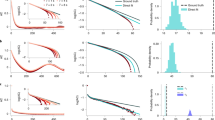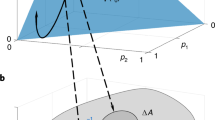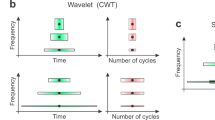Abstract
Stenner et al. reply — It was most natural to present our findings1 in the time domain, although there is an equivalent explanation in the frequency domain if Fourier analysis is used. Nimtz2 uses a frequency-domain argument to assert that our data with gaussian pulses (Fig. 1b in ref. 1) are consistent with the group-velocity approximation, whereas the data we used to measure the information velocity (Fig. 2 in ref. 1) are not; however, we disagree with his analysis.
Similar content being viewed by others
Main
For the gaussian pulses, Fourier analysis reveals that the spectrum is a gaussian function centred on the optical carrier frequency and hence has small tails extending to infinitely high and low frequencies. Based on the time–frequency relation, a measurement of the pulse can be conducted in the time domain with a resolution that is much less than the full width at half-maximum (FWHM) of the pulse because of this infinite frequency extent. It is for this reason that we are able to measure the arrival time of information with a resolution better than about 1 nanosecond.
To determine whether a pulse has too broad a spectrum for the group-velocity approximation to be valid, it is customary to compare the FWHM of the spectrum to the spectral region of anomalous dispersion. The appropriate measure for our experiment is the spacing between the gain peaks (23 MHz), which is much greater than the spectral width of about 1.1 MHz of the gaussian pulses, indicating that the approximation should be valid.
For the information-bearing pulses shown in Fig. 2a of ref. 1, the 10–90% fall-time, tf, of the waveform corresponding to symbol ‘0’ is the fastest feature in our data, measured as 47 nanoseconds. From this value, the spectral width (FWHM) of our pulses is given by 0.35/tf = 7.4 MHz. Therefore, both the gaussian and information-bearing pulses have FWHM spectral widths that are contained within the 23-MHz-wide region of anomalous dispersion, in contradiction to Nimtz's claim.
Nimtz also contests that the group refractive index over a broad frequency range is positive and equal to 3.38, but we disagree. Although the group index is positive in the narrow spectral regions centred on each of the gain lines, the group index is negative over a large spectral region that lies beyond the gain lines.
We stress that most of the spectral power falls within the primary region of anomalous dispersion for all pulse shapes. However, it is true that the power in the tails of the information-bearing pulses is larger than that in the tails of the gaussian pulses. It is the subtle reshaping of the spectrum (both in the central part and tails) by the medium that gives rise to the subluminal information transfer shown in Fig. 2 of ref. 1.
References
Stenner, M. D., Gauthier, D. J. & Neifeld, M. A. Nature 425, 695–698 (2003).
Nimtz, G. Nature doi:10.1038/nature02586 (2004)
Author information
Authors and Affiliations
Corresponding author
Rights and permissions
About this article
Cite this article
Stenner, M., Gauthier, D. & Neifeld, M. Superluminal speed of information? (reply). Nature 429, 40 (2004). https://doi.org/10.1038/nature02587
Issue Date:
DOI: https://doi.org/10.1038/nature02587
Comments
By submitting a comment you agree to abide by our Terms and Community Guidelines. If you find something abusive or that does not comply with our terms or guidelines please flag it as inappropriate.



